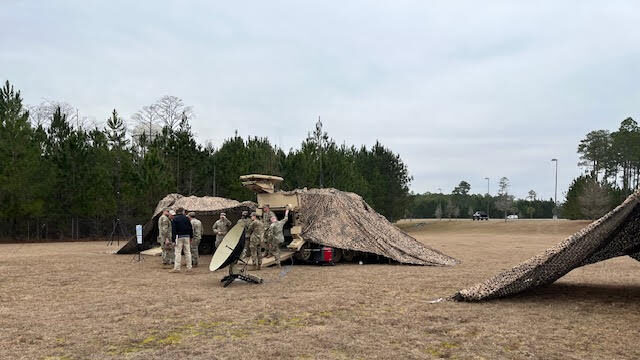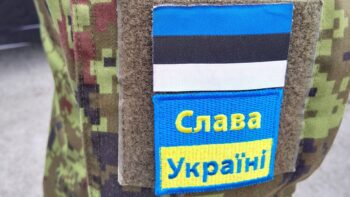
Soldiers tested potential future network gear for on-the-move formations. (Andrew Eversden/Breaking Defense)
Ft. Stewart, Ga.: Tucked inside the heavy woods of southern Georgia, Vietnam-era M1068s are positioned across the muddy swampland, transmitting invisible digital information between the thick tree trunks and through the canopy of the forest.
Soldiers here are experimenting with on-the-move communications for its armored formations, sending battlefield data to inform fires missions between dispersed platforms, the latest exercise for an Army learning to fight a digitally infused next-generation war. Ultimately, the service wants its soldiers in different platforms to have common situational awareness as it prepares to eliminate its easily-targetable command posts in the future.
“The days of us probably doing this, setting up this big tent and standing around a map are probably going away,” said Col. Terry Tillis, the commander of the 2nd Armored Brigade Combat Team of the 3rd Infantry Division, while standing in a brigade tactical operations center. “How would I have this same dialogue that I would here [with] all these people who run up and brief me every hour or two hours, [saying] ‘This is what’s changed on the battlefield,’ versus what we would actually do [when] distributed in a vehicle and how we still have that dialogue.”
Related: New Army Pilot Program To Test Armored Brigade Mobile Communications
For the last several weeks in the woods of Ft. Stewart, the Army held a pilot with elements of the 2nd Armored Brigade Combat Team of the 3rd Infantry Division, testing three different “equipment sets” of on-the-move networking tools. The technical data and soldier feedback collected will inform the planning of Capability Set ‘25, the third iteration of network modernization tools that will focus on armored formation.
The Army is modernizing its network through a series of new capabilities every two years to enable multi-domain operations and prepare for the Pentagon’s future warfighting concept, Joint All-Domain Command and Control, known as JADC2.
One of the primary goals of the pilot was to test the highly-mobile armored formations’ ability to maintain situational awareness while constantly maneuvering on the battlefield. As the service prepares for the near-peer fight, it must reduce the physical size of its large, bulky command posts, which are slow to stand up and tear down, to protect the lives of soldiers and commanders inside.
“We know on the future battlefield you got to fight dispersed and distributed,” Maj. Gen. Charles Costanza, commander of the 3rd Infantry Division, told reporters. Referring to typical tactical operations centers on the battlefield, the two-star said, “It’s just too big. And so this capability would allow us, enable us to fight a little bit more distributed and dispersed.”
For the pilot, each group of four 1068s functioned as an S6 vehicle (network manager), S2 (intelligence), S3 (operations) and fires support, and was outfitted with one of three equipment sets, integrated by General Dynamics Mission Systems. (Breaking Defense, like other outlets, accepted travel accommodations from GDMS for this visit.)
“Putting comms on-the-move kit onto a mechanized platform is one of the hardest things we do in the United States Army,” said Maj. Gen. Robert Collins, head of Program Executive Office Command, Control, Communications-Tactical.
Trying Combinations Of Line-Of-Sight And Satellite Comms
Each vehicle in the first equipment set carried a satellite connection and mesh line-of-sight communication, making it the most capable and resilient set. The second set gave flat panel SATCOM antennas to the S2, S3 and fires vehicles, but withheld the line-of-sight mesh. The third equipment set had line-of-sight capabilities but no SATCOM. In each set, the S6 vehicle had SATCOM and line-of-sight.
Across the three equipment sets, scenarios included movement to contact with the enemy, and offensive and defensive operations, while testing the ability to retain command and control and perform fires missions. Collins said the technical data collected at the pilot would be provided to the service’s centers of excellence to help inform future requirements documents, give feedback to the more than 20 industry partners that provided capabilities, and help shape the service’s acquisition strategy.
Intelligence and fires soldiers with the brigade’s 6th Squadron, 8th Cavalry Regiment, which operates close to the enemy and is responsible for tracking their units, was outfitted with the SATCOM-heavy equipment set two. Soldiers with that unit said that the SATCOM capability improved their speed when communicating with the brigade.
“The ability to process orders and … that information that we owe to our higher echelon, in order to process those, we can do those on the move without having to stop and set up,” said Lt. TJ Angevine. He added that the capability allowed the fires operators to process three fires missions in 10 minutes on the move, an “unheard of” speed.
The downside, however, was that the satellite connection sometimes failed, a real possibility in the disconnected and interference-afflicted conflict zones expected in a near-peer fight. In the event of failure, the unit would fall over to their traditional line-of-sight communications that require vehicles to be close enough together that their antennas see each other.
“There needs to be some more refinement with it,” Angevine said. “When we need it to work, we need it to work right then and there.”
Soldiers equipped with equipment set one, the most resilient set, also found their network gear to be an improvement. The issue they shared, aside from the extensive cabling, was a slight delay as the network switched between SATCOM and mesh line-of-sight.
“We found [it] to be extremely resilient when we went out to the field last week, so we’re very impressed with that,” said Maj. Brandon Pasko.
Soldiers with equipment set three told reporters that the mesh line-of-sight network provided them clear communications, but had some interference from the foliage. Users of all the equipment sets said that the new tools provided them with greater situational awareness, was easier to set up and tear down when the armored units were at-the-quick-halt, and easy to use.
“This is a perfect example of how soldiers can help inform future capabilities and systems and improve upon them,” Costanza said.
As the Army collects more feedback from the pilot, the challenge it faces is finding the right balance between capability and affordability. While it would be ideal to outfit every vehicle with a mesh line-of-sight capability and a SATCOM link, it’s also the most expensive option. As the network leaders design Capability Set ’25, still in the early stages, the focus will be finding the right balance to provide the commanders with flexibility.
“In the old school days, [the commander] may have to say ‘No, we’re going to stay where we’re at,’ and he’ll accept the risk as the commander because the juice ain’t worth the squeeze operationally,” said Col. Greg Napoli, unified network lead at the Network Cross-Functional Team. “But now he has the additional flexibility to move.”






















